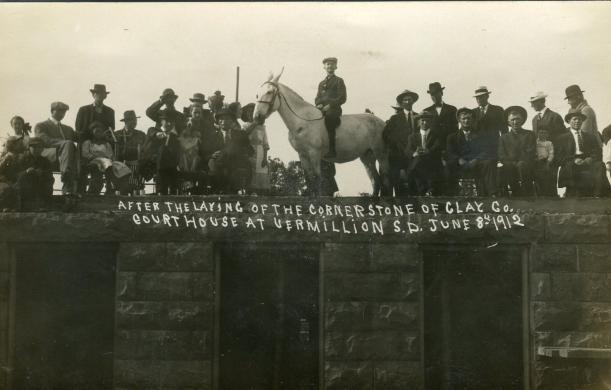Thanks to it's location along the Missouri River in southeast South Dakota, Clay County was among the first to be settled by white Americans and Europeans. Along with Union and Yankton Counties, Clay County was among the first to see telegraph service, rail service, and an organized road system. Not surprisingly, several residents of Clay County were active in the politics of Dakota Territory and, after 1889, the State of South Dakota.
Andrew E. Lee, was born in Bergen, Norway in 1847 and moved to Vermillion in 1867. Lee was South Dakota's third governor.
--Term as Governor: 1897-1901.
--Political Affiliation: Populists (1st term); nominated by Silver Republicans, Democrats and Populists (2nd term).
--Occupation: General mercantile, farming business that involved stock breeding.
--Notable events: Governor Lee was in office during the Spanish-American War – a group of more than 1,000 men assembled as the First Volunteer Regiment from South Dakota.
Andrew E. Lee died in 1934 and is buried at Bluff View Cemetery in Vermillion.
Peter Norbeck was born in 1870 to Swedish/Norwegian parents living in a dugout north of Vermillion. Norbeck was South Dakota's ninth governor.
--Term as Governor: 1917-1921
--Political Affiliation: Republican.
--Occupation: Businessman, well driller.
--Notable Events: Governor Norbeck was South Dakota's first native-born governor and United States Senator (1921-1936).
Norbeck died in 1936 and is buried at Bloomington Church Cemetery, Platte, South Dakota.
Carl Gunderson was born in 1864 in a log cabin near Vermillion. He acquired his own homestead and always considered Clay County his home. Gunderson attended the University of South Dakota and was South Dakota's eleventh governor.
--Term as Governor: 1925-1927
--Political Affiliation: Republican.
--Occupation: Farmer, mercantile owner, survey engineer, allotment agent, lieutenant governor.
--Notable Events: In 1910-1911, Governor Gunderson was named the supervisor of all United States allotting agents.
Gunderson died in 1933 and is buried at Bluff View Cemetery in Vermillion.
Rose Bower was born in 1873 in Vermillion. Her family moved to the Black Hills in 1885. She was raised in a musically talented family and trained at the Chicago Musical College and the New England Conservatory of Music. The Bower Family Band was well known in Rapid City and around the state.
Bower became involved in the Women's Christian Temperance Union and the National American Woman Suffrage Association and held positions of leadership in both. Rose Bower's skills as a cornet player were eventually put to use at suffrage events, where she rallied attendees and punctuated presentations with rousing tunes. Bower also worked as a librarian, teacher, writer, and lecturer. Between 1907 and 1917, she spent considerable time traveling the country, playing, speaking, and raising money at suffrage events. After her father died in 1917, Bower moved to Custer County, South Dakota to take over the operation of the family ranch.
Rose Bower died in 1965 and is buried at Mountain View Cemetery in Rapid City.



